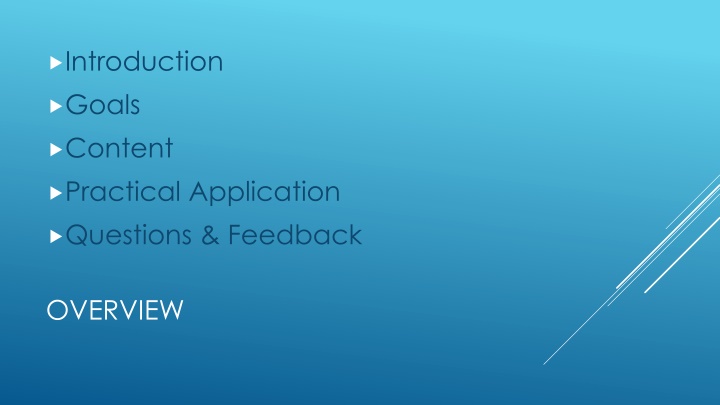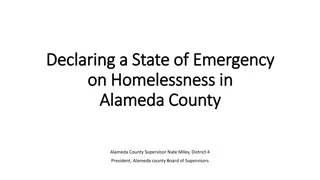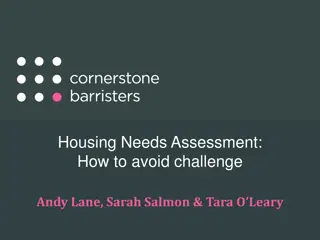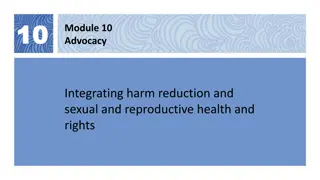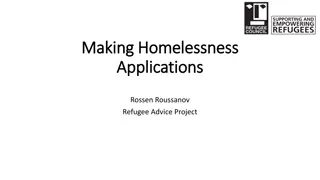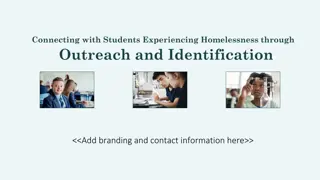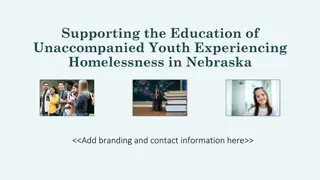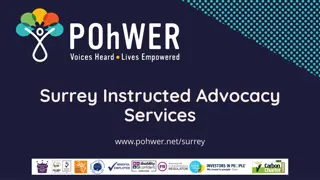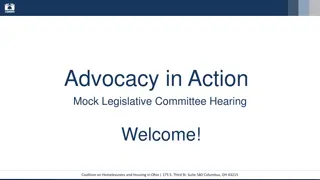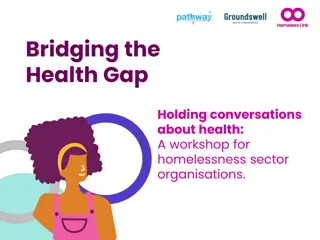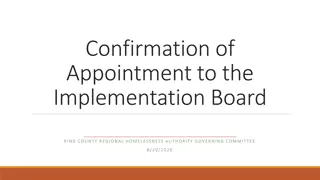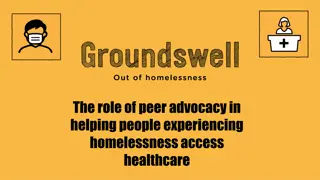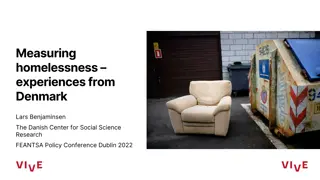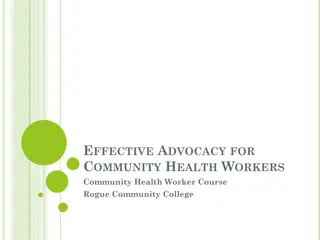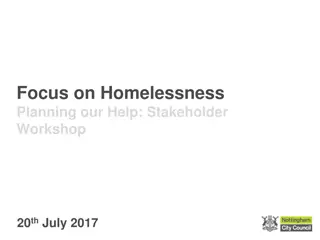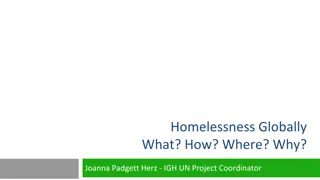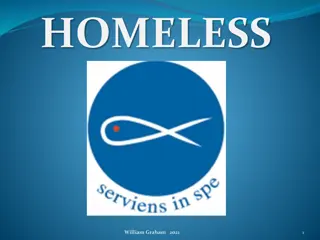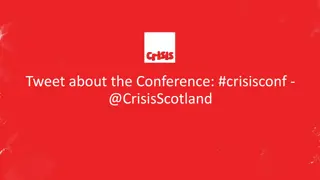Empowering Educational Advocacy for Students Experiencing Homelessness
Explore the complexities of student homelessness with Dr. Kisha Napper, focusing on raising awareness, understanding diverse experiences, and providing strategies and resources. Delve into essential terminology, identify support settings, and address challenges like financial hardship and safety issues. Uncover the McKinney-Vento Act and learn how to bridge gaps to support vulnerable students effectively.
Download Presentation

Please find below an Image/Link to download the presentation.
The content on the website is provided AS IS for your information and personal use only. It may not be sold, licensed, or shared on other websites without obtaining consent from the author.If you encounter any issues during the download, it is possible that the publisher has removed the file from their server.
You are allowed to download the files provided on this website for personal or commercial use, subject to the condition that they are used lawfully. All files are the property of their respective owners.
The content on the website is provided AS IS for your information and personal use only. It may not be sold, licensed, or shared on other websites without obtaining consent from the author.
E N D
Presentation Transcript
Introduction Goals Content Practical Application Questions & Feedback OVERVIEW
WHOS IN THE (VIRTUAL) ROOM? Good Morning, Everyone!
FROM HERE TO THERE: BUILDING BRIDGES FOR STUDENTS EXPERIENCING HOMELESSNESS Dr. Kisha Napper, NCC Educational Advocate Special Populations Consultant
Heighten awareness about students experiencing homelessness Understand the diversity of students lived experiences Identify strategies and resources to support students experiencing homelessness in collaboration with other stakeholders SESSION GOALS
Dont assume anything. First things first Maslow to Bloom THE BASICS
McKinney Vento Act (MCV) Homelessness: MCV vs HUD Doubled Up Unaccompanied Youth IMPORTANT TERMINOLOGY
Immigrant Migrant Refugees Unhoused, unsheltered, homeless, in transition IMPORTANT TERMINOLOGY
Children or youth who lack: Fixed-unchanged Regular-consistent Adequate-sufficient by law/reasonable MCKINNEY-VENTO ACT
Doubled up, hotel, motel, campground, trailer, tent, shelter, park, car, public spaces, substandard living, or similar settings [42 U.S.C. 11434a(2)] SETTINGS
Financial hardship Job loss/eviction/health Domestic violence Natural disaster Safety issues And more DOUBLED UP BY NECESSITY
By Choice Options Access DOUBLED UP BY CONVENIENCE
Many barriers impede student success. Distinct from poverty Lifespan issues Negative educational outcomes WHAT S THE ISSUE?
Increased likelihood of homelessness (4.5) Growing numbers Vulnerable Subpopulations WHAT S THE ISSUE?
More than 1.5 Million children and youth have been identified as experiencing homelessness in public schools (NCHE, 2021). Tennessee Locally CONTEXT
Regionally Rural Urban Suburban CONTEXT
Greater challenges Household income Race/ethnicity Immigration status SUBPOPULATIONS
Pregnancy status Education level Sexual orientation SUBPOPULATIONS
Education is powerful. Education can break the cycle of homelessness. Education is the key to helping students experiencing homelessness. WHAT S THE ANSWER?
UNHOUSED UNSHELTERED HOMELESS IN TRANSITION Experiencing homelessness WHAT S IN A NAME?
Identification Immediate enrollment vs services Implement procedures to remove barriers for students School stability Best interest Transportation Support for Academic Success (HS & Beyond) LEGAL RESPONSIBILITY
Do you feel prepared to serve students experiencing homelessness? What do you need to know more about to support students experiencing homelessness? What are you doing that s working? What s challenges do you have? QUESTIONS FOR YOUR CONSIDERATION
Please pay attention. Communicate honestly. Strengths-Based Approach MENTAL HEALTH & SEL (WITH AND FOR STUDENTS)
Encourage and support Future Story Empower MENTAL HEALTH & SEL
Advocate. Maintain confidentiality. Need to know Commit. SPECIFIC TO COUNSELORS (AND OTHERS)
High mobility often causes academic issues. Attendance and Truancy Achievement and Intervention Students can get lost in the shuffle. ACADEMIC CONSIDERATIONS
IT IS IMPORTANT UNDERSTAND THE BARRIERS ASSOCIATED WITH STUDENTS LIVING CONDITIONS.
Homelessness is varied. Living situations are different for each family. Understanding is key. BARRIERS BY LIVING SITUATION
Health Hygiene Food Clothing Responsibilities Structure Vital documents Transportation Working families Financial issues Credit issues SITUATIONS TO CONSIDER
MCV Act Requirements Implementation Stability and Consistency Graduation and Beyond HOW DO WE BUILD BRIDGES TO SUCCESS?
Collaboration Fidelity Equity HOW DO WE BUILD BRIDGES TO SUCCESS?
No identification No access Improve Remove Extra EQUITABLE SUPPORT
Identification and access Support to succeed Graduation and beyond Connect to resources Monitor progress IT ALL STARTS HERE.
Quarter: School: Student Name & Grade SPED/RTI Class Failed/Teacher Name Grade/Credit Recovery Teacher Strategies to Address Failing Grades Subject Grade Intervention Time ACADEMIC MONITORING
Attendance Academics Behavior Coursework Credit Accrual ABC S OF HELPING
Village Thinking Stakeholder Support Who knew? BUILD A COLLABORATIVE TEAM
Self care isnt selfish. Oxygen mask Compassion fatigue is real! EXERCISE SELF-CARE
Interventionists Bus Drivers Community Stakeholders Students and Families SRO s District Liaison School Level School Counselors (MH Support) Teachers Administrators WHO S ON THE TEAM?
EVERY KID IS ONE CARING ADULT AWAY FROM BEING A SUCCESS STORY. -Josh Shipp REMEMBER.
National Center for Homeless Education Schoolhouse Connections National Association for the Education of Homeless Children and Youth POLICY & PRACTICE
DR. KISHA NAPPER, NCC Educational Advocate Special Populations Consultant connect@napperconsultingservices.com
